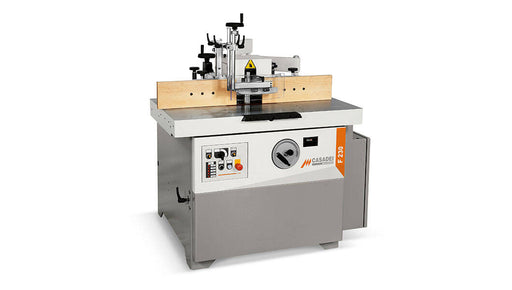A spindle moulder, also known as a shaper in North America, is a woodworking machine used to shape and profile wood stock by spinning cutting tools or blades mounted on a horizontal spindle. Its primary function is to create decorative profiles, grooves, and joints on the edges or surfaces of wooden workpieces.
Key Features of a Spindle Moulder
Powerful Spindle Motor: Spindle moulders feature high-powered motors to drive the spinning cutting tools, providing the necessary torque and speed for efficient material removal and shaping.
Multiple Spindle Options: Many machines come with interchangeable spindles of various diameters and lengths, allowing for a wide range of cutter sizes and profiles to be used for different woodworking tasks.
Adjustable Spindle Speed: Some spindle moulders offer adjustable spindle speeds to accommodate different cutting tool diameters and material types, ensuring optimal cutting performance and finish quality.
Vertical and Horizontal Adjustment: Spindle moulders may feature vertical and horizontal adjustment mechanisms for the spindle, allowing operators to precisely position the cutting tools for accurate shaping and profiling.
Large Worktable with Fences: Machines are equipped with large worktables and adjustable fences to support and guide the workpiece during shaping operations, ensuring stability, accuracy, and safety.
Applications of Spindle Moulders
Profile and Moulding Production: Spindle moulders are commonly used in millwork shops and furniture factories to produce decorative profiles, moldings, and trim pieces for architectural and furniture applications.
Joinery and Cabinetry: Woodworkers utilize spindle moulders to create joinery elements, such as tenons, mortises, and dovetails, as well as to shape and profile cabinet components, drawer fronts, and door panels.
Edge Profiling and Beveling: Spindle moulders are employed to shape and bevel the edges of tabletops, countertops, and panel components, providing custom edge profiles and finishes for woodworking projects.
Panel Raising and Grooving: Woodshops use spindle moulders to raise panels and cut grooves or slots in wooden panels for frame-and-panel construction, door making, and other custom woodworking applications.
Choosing the Right Spindle Moulder
Spindle Size and Speed: Consider the range of spindle sizes and speeds offered by the machine to ensure it can accommodate the cutting tools and material types you plan to use for your woodworking projects.
Adjustability and Precision: Look for a spindle moulder with precise adjustment mechanisms for the spindle height, angle, and fence positioning, allowing for accurate shaping and profiling of workpieces.
Safety Features: Evaluate the safety features of the machine, such as spindle brakes, emergency stops, and safety guards, to ensure operator safety and compliance with workplace regulations.
Dust Collection System: Choose a spindle moulder with an efficient dust collection system or port to capture cutting dust and debris, keeping the work area clean and reducing airborne particulates for a healthier working environment.








